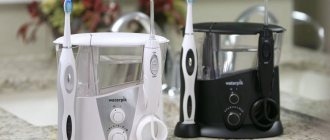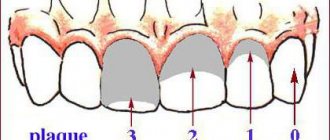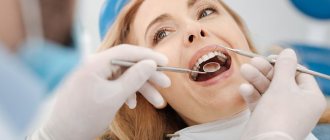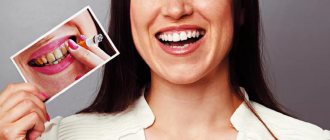What is proper oral hygiene
The goal of proper personal oral hygiene is to make your teeth healthier, your breath fresh and pleasant, and to prevent bleeding gums and the formation of yellow plaque. As a result of proper care, your smile will become attractive and snow-white, and the main result is the prevention of dental diseases.
Proper nutrition is also very important. For example, apples strengthen enamel.
There are several indicators of proper and effective oral hygiene:
- clean teeth without stuck pieces of food;
- pink gums that do not hurt or bleed when brushing;
- no bad breath;
- There is no pain when chewing food.
If the condition of your teeth does not correspond to at least one of these signs, you need to contact your dentist. If necessary, he will provide treatment and give advice on oral care, recommend suitable toothbrushes and pastes, and point out problem areas.
How to choose dental floss
Dental floss is another helpful tool if you need to brush your teeth after eating. Instead of using toothpicks found in all cafes and restaurants after lunch or dinner, it is better to use dental floss. A toothpick, due to its shape (a fairly thick base and a sharp tip), is not able to clean the crevices between the teeth, but at the same time it injures the gums. Dental floss is very thin, which allows it to penetrate between the teeth without contacting the gums. Let's figure out how to choose the right dental floss.
Dental floss varies in thickness and composition. In terms of thickness, choose thicker threads if you have large distances between your teeth and thin ones if there is crowding or your teeth are very tightly spaced. The thickness of the thread is always indicated on the packaging. Use waxed floss; it moves easier between your teeth and even makes a distinctive sound when your teeth are cleaned. If you wear braces, unwaxed floss is contraindicated because it will simply get tangled in the brackets.
Some manufacturers offer flavored dental floss, but mint or other flavors do not affect the quality of the floss in any way, so it is called a matter of taste. You can also choose dental floss fixed between two plastic holders. This option will make brushing your teeth easier and free up your other hand.
The main purpose of dental floss is to clean teeth in hard-to-reach places, thus preventing the accumulation of bacteria, the formation of plaque and tartar. Naturally, we do not have the opportunity to always take a toothbrush with us to carry out oral hygiene after every meal. This is not required - brushing your teeth with a brush and toothpaste twice a day is enough. But you need to get rid of food deposits on time. This is why it is recommended to carry dental floss with you. And now you know how to choose dental floss.
The importance of proper oral care
The need to take care of your oral cavity is obvious. The purpose of hygiene procedures is, first of all, the prevention of caries, periodontal disease and other diseases that can lead to tooth loss. Irregularity of procedures leads to the fact that plaque remains on the surface of the enamel, and food debris accumulates in the gaps, which rot and create a comfortable environment for the proliferation of pathogenic bacteria. As a result, bad breath appears and gum disease develops.
If plaque remains on the teeth for a long time, it mineralizes and turns into tartar, which cannot be removed at home. The stone causes deformation and thinning of tooth enamel, making it more sensitive and painful.
But proper oral hygiene is important for more than just dental health. According to doctors, there are more than 60 diseases that are directly or indirectly the result of dental problems. Among them:
- diseases of the cardiovascular system;
- rheumatism;
- digestive problems;
- kidney disease;
- skin rashes;
- nervous disorders.
Therefore, systematic and competent hygiene of teeth and gums is important for the overall health of the body.
Personal hygiene
Represents daily oral care using special products:
- special brush;
- toothpaste or powder;
- floss;
- conditioner balms.
The main method of hygiene is the daily removal of food debris that harms the enamel and tooth tissue. The mucous membrane is well supplied with blood and serves as a site of colonization and infection by bacteria. If you do not pay enough attention to hygiene, active reproduction of pathogenic flora will begin.
General principles of good oral hygiene
The first and most important rule, which even children know, is the immutable truth that teeth should be brushed twice a day. This must be done correctly, with a specially selected brush. In addition, it is necessary to additionally clean the interdental spaces using floss.
But there are also nuances that not everyone knows:
- For dental health, it is necessary to adhere to a proper diet, avoiding snacks between main meals;
- choose toothpastes and rinses containing fluoride, which strengthens the enamel;
- after brushing your teeth and eating, use rinses that will destroy bacteria where the toothbrush cannot reach;
- Brush your teeth for at least two minutes.
Don't skimp on brushing your teeth properly. This can lead to serious problems in the future.
Brushes for cleaning interdental spaces
The brushes are designed for cleaning interdental spaces, spaces under fixed orthodontic arches, areas of bridges and spaces between implants. The brushes vary in shape - conical, cylindrical, and in size.
Recommendations for use:
1. Bring the brush to the interdental space. Find the correct angle of the brush for comfortable and easy insertion of the brush.
2. Gently insert the brush until it comes out the other side.
3. Make one or two back-and-forth movements, remove the brush and rinse it under running water.
4. Proceed with cleaning the next interdental space.
5. Never insert the brush into narrow interdental spaces with force. A properly selected brush easily fits into the interdental spaces. Your dentist or hygienist will help you choose the right size brush.
6. It is recommended to change the brush every 5-7 days.
Professional hygiene
If the plaque has already turned into stone, only a dentist can remove it. At the same time, it is not possible to completely remove plaque even if you follow all the rules for brushing your teeth. Therefore, everyone who cares about their dental health is recommended to visit the dentist twice a year and have their teeth professionally cleaned. In advanced cases, gingivitis also forms, a painful inflammation of the gums.
What does professional oral hygiene include?
The first stage of oral care in the dental office is diagnosis and analysis of existing problems. Based on these, procedures are prescribed, which most often include cleaning plaque and stone (if necessary, with anesthesia).
Pigmented plaque is cleaned with a special Air Flow apparatus, which operates using a jet stream of aerosol containing sodium bicarbonate.
In modern dental clinics, ultrasound is used during cleaning, which removes soft and hard deposits from the enamel. In this case, the teeth are not damaged, plaque and stone are gently peeled off from visible surfaces.
The next stage is the treatment of intergingival spaces. This is a manual procedure that requires care and professionalism from the dentist.
After the stone is removed, the enamel is polished to protect it from bacteria. This is done using polishing pastes and special brushes and rubber bands.
Professional cleaning ends with the application of fluoride-containing varnish to the enamel, which provides additional protection and makes teeth less sensitive. The price of such a procedure depends on many factors, but you should not skimp on dental health.
Professional care
At an appointment with a specialist, teeth are cleaned with ultrasound.
A special device will remove plaque from the enamel and formed stones at the base of the teeth and under the gums. This procedure is virtually painless. You can't do this yourself. Stones and plaque appear after drinking tea, coffee, and cigarettes. The doctor will check the oral cavity for diseases (periodontal disease) and damage to the enamel (caries). If necessary, he will select the correct treatment and recommend proper dental care.
To strengthen tooth enamel, a specialist can perform fluoridation. It can be ordinary and deep, when special preparations are placed at the base of the tooth, which quickly restores the enamel.
Teeth whitening is carried out using the Air Flow system. It allows you to restore the natural color of your teeth and destroys bacteria. A special sandblasting machine is used, inside of which there is a special solution and an abrasive mixture. With its help, plaque is removed and tooth enamel is polished.
Oral hygiene products
To effectively care for your teeth at home, you need to purchase several items. Toothpaste and a brush alone are not enough to clean the interdental space. If you neglect additional means, pathogenic bacteria and food debris will accumulate there, causing problems (including tooth loss).
Toothbrushes
You should select a toothbrush individually, taking into account several factors. First of all, this is the stiffness of the bristles and the size of the handle. The bristles are of medium hardness and are universal. Soft brushes are recommended for gum disease and bleeding, while hard brushes are recommended for very strong teeth or for dentures. The latter must be used with caution, because improper brushing with it will lead to serious damage to the gums and enamel.
The optimal length of a toothbrush handle is about 30 mm.
Effective dental care begins with choosing the right toothbrush. It is equally important to store it correctly. It is important that the brush dries quickly because moisture promotes the growth of bacteria. In addition, it is recommended to store brushes without a case.
The quality and effectiveness of teeth cleaning depends not only on the stiffness of the bristles, but also on the shape. Dentists do not have a consensus on this indicator. For example, brushes with fibers that form a V-shape clean the V-shape more effectively. Bristles of different heights remove plaque from the cervical area, as they effectively penetrate into the gingival sulcus.
The brush needs to be changed every 3 months.
Toothpastes
Another essential oral care product. Depending on the condition of the teeth, you can choose a therapeutic or prophylactic agent. Textures also vary - from gel-like to creamy. Most toothpastes contain fluoride, but its percentage varies. If you can choose a prophylactic paste yourself, based on reviews and advice from friends, then a therapeutic paste can be chosen only on the recommendations of doctors.
For one brushing of your teeth, it is not necessary to squeeze out a large amount of paste - a pea-sized volume is enough.
You should change your toothpaste every few months to ensure comprehensive oral care. Anti-bleeding agents can be alternated with strengthening and whitening agents. For example, in the morning you can use pastes against caries, and in the evening against inflammation. Before you buy baby toothpaste, study the special lines of famous brands.
Dental floss
Dental floss (or floss) is necessary to completely clean the interdental space. There are several varieties: flat, round, twisted. The threads may be coated with wax.
It is necessary to select a specific floss taking into account individual characteristics. First of all, it is worth considering the distance between the teeth. Without dental floss, comprehensive oral care is impossible; only it can completely remove food debris and prevent the proliferation of pathogenic bacteria.
Tongue cleaners
It is necessary to cleanse not only your teeth and gums of bacteria, but also your tongue. The plaque that forms on it causes bad breath and promotes the development of bacteria. To remove plaque, you can use special toothbrushes, which are equipped with a special rubber ribbed surface on the back. There are also separate tools for this procedure. It is necessary to clean the tongue by making careful movements in the direction from the base to the tip.
Rinse aids
You should use mouthwash at least twice a day, after each brushing of your teeth. It is also useful to apply them after each meal to avoid the growth of bacteria in rotting pieces of food.
Regular use of fluoride rinses for 30 seconds helps to further clean the teeth and mucous membranes. They help remove plaque, bacteria, and waste products from hidden and hard-to-reach areas of the oral cavity. These products contain various useful components, for example, purified essential oils, menthol, which reduce the concentration of microbes, protect the enamel from caries, reduce inflammation and bleeding of the gums, and remove bad breath.
General hygiene rules
There are simple rules for caring for your teeth and oral cavity. They must be taught from early childhood. The best thing is the example of adults. Forming such a habit is a very important step in creating a “Hollywood smile” in the future. To do this you need:
- Brush your teeth thoroughly every morning. The second time must be before bedtime;
- after snacks, clean with a special thread (floss);
- use fluoride-containing pastes;
- visit the dentist 2 times a year.
Proper nutrition is also important to keep your mouth healthy. A lack of fluoride can lead to premature destruction of tooth enamel. Products containing many chemical fillers (chips, crackers, carbonated sweet water) negatively affect the appearance of teeth and lead to darkening.
How to brush your teeth correctly
To ensure proper oral hygiene, it is not enough to choose the right toothbrush, toothpaste and other products. Proper cleaning technique must be followed to completely remove plaque and tartar from the enamel surface. The basic rules of this procedure are as follows:
- making rotational movements, trying to remove food debris from the interdental space, move it from the gum to the tooth;
- Using gentle back-and-forth movements, clean the entire tooth: outer, inner and chewing surfaces. The procedure should take about 3 minutes;
- clean the surface of your tongue to freshen your breath and rid your mouth of bacteria as much as possible;
- use dental floss;
- Rinse your mouth with mouthwash for 30 seconds.
Dentists distinguish several methods of brushing teeth. The appropriate one is determined individually; it is better to consult a dentist about this. What all methods have in common is that they are performed for at least three minutes and at the same pace.
On average, instead of the allotted three minutes, people spend 46 seconds brushing their teeth.
Universal cleaning suits everyone. With it, two teeth are cleaned in turn in the direction from the gums to the cutting part of the tooth. The outer side of the teeth is cleaned first, and only then the inner side. If there are no gum diseases, you can complement the procedure with a massage using circular movements of the gums.
During standard brushing, the brush should be held at a 45-degree angle to the gum.
Brushing harshly will help remove plaque effectively, but is not suitable for people with painful gums. The brush is positioned perpendicular to the buccal surface and moves in a circle from the internal surfaces to the chewing surfaces.
Gentle brushing will not harm sensitive gums. Vertical movements from the gums down are made with the teeth closed when cleaning the front surface and with the jaw open when cleaning the inner surface.
The technique of using dental floss also implies several rules. First, the floss should be about 45 cm long. For each brushing, use a new section 3-5 cm long. The interdental spaces should be cleaned with gentle movements, following the contours of the gums. Go to the surface of the teeth below the gum line, but do it carefully, avoiding sudden movements.
Toothpastes
Used to brush teeth twice a day, morning and evening. If the oral cavity is in normal condition, hygienic pastes are used - with a standard composition, removing soft plaque from the surface of the enamel, freshening breath. Therapeutic and prophylactic pastes are used if a person has problems with the health of teeth or gums. Combined pastes are an intermediate option; they can be used for the prevention of dental and periodontal diseases periodically, from time to time.
The composition of therapeutic and prophylactic pastes may contain fluorides, phosphates, calcium, amino fluoride, fluorine. These elements strengthen the enamel and saturate it with minerals. The fluoride content in the paste according to the PPM index in this case should be more than 0.15%.
If toothpaste is to be used to prevent gum disease, it should contain antiseptics and anti-inflammatory components. These are chlorhexidine, tin fluoride, triclosan. Herbal antiseptics and anti-inflammatory components (extracts of chamomile, nettle, eucalyptus, etc.) have almost no effect and do not provide effective prevention of inflammation.
If the enamel is sensitive, you can use pastes that contain mineral components (fluorides, nitrate or potassium chloride, strontium chloride). Their concentration must be high. They will strengthen the enamel, help seal the dentinal tubules and reduce tooth sensitivity.
Hygienic toothpastes can be whitening: they better remove soft plaque from the surface of teeth and help lighten the enamel due to this. Such compositions are abrasive. Paste manufacturers indicate it in the RDA. If the indicator exceeds 100-120 units, the abrasiveness is high. If the abrasiveness is more than 120 units, frequent use of the paste can be dangerous for the enamel.
Teeth whitening can occur due to the content of enzymes in toothpaste (papain, bromelain, polydone, pyrophosphates, etc.). These substances dissolve soft deposits on the enamel surface and ensure their removal without an abrasive effect.
When using toothpastes with special (mineralizing, whitening, anti-inflammatory) effects, DentoSpas dentists recommend:
- consult with your doctor and brush your teeth with the toothpaste recommended by him;
- Follow proper teeth brushing technique;
- Do not use the same paste for a long time, constantly. With constant use, bleaching compounds damage and destroy enamel. Anti-inflammatory pastes can change the microflora of the oral cavity.
Whitening or hygienic pastes do not replace the procedure of professional teeth cleaning: if plaque accumulates on the surface of the enamel or tartar forms, they must be periodically removed in the dentist’s office. In case of gum disease, the use of prophylactic pastes should not replace visits to the periodontist and preventive procedures performed by him.
Material and methods
The study was conducted at the Department of Therapeutic Dentistry of the Perm State Medical University named after. THEM. Sechenov. A non-randomized controlled trial with a split-mouth design was conducted.
At the first stage, 76 patients were screened and a study group of 25 people (10 men and 15 women) was formed.
Inclusion criteria: written informed consent of the patient to participate in the study; age from 18 to 35 years; intact periodontium.
Non-inclusion criteria: presence of non-removable orthopedic and orthodontic structures in the oral cavity; partial edentia; presence of implants; the presence of carious cavities; presence of inadequate restorations according to class II; supragingival calculus.
Criteria for excluding patients from the study: patient refusal to further participate in the study; failure to comply with study recommendations.
All patients were recommended a Curaprox 5460 toothbrush (Curaprox, Switzerland) as the main hygiene product; in the 1st quadrant, individually selected CPS Prime brushes (Curaprox, Switzerland) were additionally used; in the second, Curaprox floss (Curaprox) , Switzerland), in the third - monobeam brush Curaprox 1006 (Curaprox, Switzerland), in the fourth quadrant no additional products were used.
The hygienic state of the oral cavity was assessed using the Silness-Loe and Navy-Rustogi indices immediately before the start of the study and after 4 weeks.
The study was approved by the Local Ethics Committee of the Perm State Medical University named after. THEM. Sechenov (Sechenov University): Order No. 470 R dated October 19, 2012 “On the creation of a local ethics committee”, minutes No. 05−17 of the meeting of the Local Ethics Committee dated 06/14/17.
Professional cleaning
Since it is impossible to provide proper protection of the oral cavity from caries and other more serious diseases at home, dentists insist on visiting professional cleaning at least twice a year. The main advantages of this procedure:
- reduction of pathogenic microflora;
- increasing local immunity;
- removal of dental plaque.
Professional cleaning includes several stages:
- Removing soft plaque using the Air Flow air-abrasive technique. The device precisely delivers a powerful water-air jet, saturated with small abrasive particles, onto the tooth surface. Thanks to this, the area of the periodontal canals is cleared of pigmented plaque.
- Ultrasonic cleaning. Has antibacterial and antimicrobial effects. Thanks to thin attachments, the ultrasonic method helps remove stone from the supragingival part of the tooth, from under the gum and from the gingival canals.
- Polishing enamel with special pastes. To prevent plaque from sticking to the teeth, their surface should be as smooth as possible. Phyto-extracts have a mild whitening effect and also help strengthen the enamel.
- Strengthening fluoride therapy. This stage is not mandatory, but is carried out at the request of the patient. Disposable mouth guards are filled with a special remineralizing gel and placed on the upper and lower jaw. The gel lasts until it forms a thin protective film and is then washed off with water.
“Even with high-quality personal hygiene (and not everyone can boast of it) and cleansing of soft plaque, hard plaque (tartar) forms. This is due to both food debris and the mineral composition of saliva. Dental plaque contains a huge number of bacteria that cause and maintain inflammation in the periodontal tissues (tissues surrounding the tooth). Constantly inflamed gums cause bad breath, bleeding, and the saddest consequence is the destruction (loss) of bone tissue around the tooth. This disease is called periodontitis or periodontal disease, and it is what leads to tooth loss. With age, the rate of formation of hard plaque increases, and the risk of remaining without teeth increases. Regular professional hygiene allows you to promptly remove hard plaque and, therefore, protects teeth from falling out.”
Sergey Andreev
Candidate of Medical Sciences, dentist-therapist, orthopedic dentist, pediatric dentist











